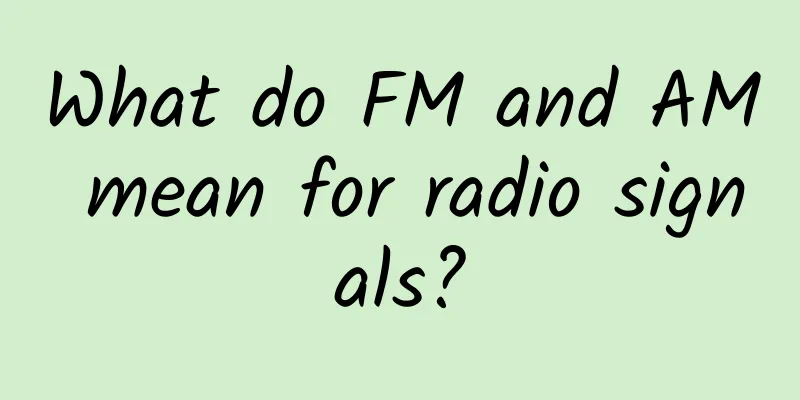What do FM and AM mean for radio signals?

|
We often hear on the radio: FM 96.6 MHz, AM 927 kHz. What do FM and AM mean? How do we send music from the transmitter to the radio? We mentioned before that signals can be transmitted using radio transmitters, and people made wireless telegraphs based on this principle. However, wireless telegraphs transmit Morse code, while broadcasting requires the transmission of sound. How can this be done? Marconi, the father of radio Since radio must have a high enough frequency to be effectively transmitted, for example, most broadcast frequencies are from hundreds of kilohertz to hundreds of megahertz. The Economic Voice of China National Radio is FM96.6MHz, which means that there are 96.6 million cycles of electromagnetic waves per second. But the frequency of the sound waves we speak is much lower, only a few hundred hertz. How can we turn our words into radio signals? This involves a concept: modulation. 01 Signal debugging Just like sending a courier, we need to use a box to pack the goods. The low-frequency signal is what we need to transmit, just like the goods; we then generate a high-frequency signal, which is our carrier, just like the box. We let the high-frequency signal change with the low-frequency signal, just like loading the goods on a carriage. This process is called modulation. If we let the frequency of the high-frequency signal change with the low-frequency signal, this process is called frequency modulation or FM. If the amplitude of the high-frequency signal is changed with the low-frequency signal, this process is called Amplitude Modulation or AM. 02 Emission of radio waves The modulated signal can be transmitted. A circuit consisting of a capacitor and an inductor is called an LC loop. An oscillating electromagnetic field will be generated in the LC loop, emitting electromagnetic waves. Research has found that the smaller the capacitance in the circuit, the higher the radio frequency emitted. Therefore, in order to transmit high-frequency signals, we reduce the area of the two plates of the capacitor. At the same time, in order to make the range of electromagnetic wave emission large enough, we can place one of the two plates of the capacitor at the top and the other at the bottom, which constitutes an antenna. We load the modulated current signal onto the antenna through electromagnetic induction, and the antenna can help us transmit the radio. 03 Propagation of radio waves How does radio travel in the air? Please note that since the earth is round, if radio travels in a straight line, it is difficult to extend to a large range. How do people make radio transmission farther? There are three ways. Radio with a longer wavelength is called long wave. Long waves can easily bypass obstacles. This phenomenon is called diffraction. Therefore, long waves are mainly transmitted by ground waves. Ground waves are when radio moves along the ground. It will diffract and bend to reach the receiving device. This type of radio is generally used for long-distance wireless communication. Radio with shorter wavelengths is called medium wave. Medium wave has poor diffraction ability and cannot be transmitted by ground wave. However, there is a special layer in the atmosphere called ionosphere. The ionosphere can reflect medium wave. Therefore, radio can be transmitted by repeated reflection between the ground and the ionosphere. This method is called sky wave. The idea of ionosphere and sky wave transmission was first proposed by Tesla. Telegraph and broadcasting generally use sky wave transmission. Radio with a wavelength shorter than medium wave is called short wave and microwave. This wave has a very short wavelength and is difficult to diffract, so it cannot be transmitted using ground waves. At the same time, this wave easily penetrates the ionosphere and cannot be transmitted by sky waves. The transmission method of short wave and microwave is generally linear propagation, that is, the signal is received and amplified in sections through the repeater on the elevated iron tower and then continued to be transmitted. The principle of mobile phone radio signal propagation is linear propagation. At the beginning, each of the major mobile operators, including China Mobile, China Unicom, China Netcom, and China Telecom, had to build towers and base stations, which was very wasteful. Finally, the state stepped in to coordinate, and several major operators jointly funded the establishment of China Tower Corporation, which was specifically used to build base station towers, realizing resource sharing. With the emergence of artificial satellites, people are more likely to send this signal directly to the satellite, and then transmit it to another location on the ground via the satellite, thus saving base stations. 04 Reception of radio waves The radio also has an antenna, which is a conductor. When the radio signal encounters a conductor, it will stimulate the same regular induced current on the conductor, but this current is relatively weak. However, the receiving antenna is also an LC loop, and it also has a natural frequency. If the frequency of the receiving antenna is the same as the radio frequency in space, electromagnetic resonance will occur, and the induced current on the antenna will be the largest at this time. For example, if we want to listen to FM96.6, we adjust the natural frequency of the receiving device to 96.6MHz. At this time, the induced current caused by the economic sound in the circuit is the largest. Although other radio station signals also have induced currents in the circuit, there is no resonance, so the current is very small. The process of adjusting the inherent frequency of the receiving device is actually adjusting the size of the capacitor in the radio. This process is called tuning, which is what we call searching or changing channels in our daily life. 05 Signal demodulation When we receive the FM96.6MHz Economic Voice channel, can we directly pass the current to the speaker? The answer is no. Because the signal we receive is a modulated high-frequency signal, just like receiving a package, we need to unpack it first. We need to detect the low-frequency signal from the high-frequency signal, and this process is called demodulation. We use the opposite method of modulation to filter out the high-frequency signal, leaving the low-frequency signal. Then, this signal is amplified and sent to the speaker. The coil in the speaker vibrates back and forth under the force of the magnet on the current, driving the diaphragm that makes sound, and we can receive the beautiful singing played on the radio! To sum up, the broadcasting process is as follows: the signal is modulated into a high-frequency signal, transmitted through an antenna, reaches the receiving end through various means, is received by the receiving device after tuning, and then demodulated to become the original signal. The principles of radio devices such as televisions and mobile phones are the same. However, there are some differences. Broadcast signals are generally continuously changing, and such signals are called analog signals. Mobile phone signals are generally digital signals, which have only two states, 0 and 1, and are the same as the principles of computers. Using digital signals, information processing and calculation can be easily realized. END |
<<: Do you hold your phone with your little finger? Doctors warn...
>>: How can we have high-quality sleep?
Recommend
What knowledge and stories are behind eating Qingtuan during the Qingming Festival?
As spring comes and Qingming Festival approaches,...
Is your height all due to genetics? Master these points and your child will grow 10cm taller!
As a topic of concern to everyone, height is the ...
Ma Huateng's "prediction" has come true? Scanning code payment will become a thing of the past, and WeChat is also "threatened"
Around 2015, Ma Huateng expressed his concerns ab...
The one in the friend circle is not you at all
You post pictures of delicious food you enjoyed w...
China Association of Automobile Manufacturers: China's new energy vehicle market fell by about 4.0% in 2019
According to the China Association of Automobile ...
What are the promotion and operation skills of Pinduoduo? Do these 4 things and you won’t worry anymore
What are the promotion and operation skills of Pi...
Are glasses purchased online reliable?
Online shopping is becoming more and more popular...
Pricing and product selection thinking for live streaming sales!
“Is it feasible to start by selling cheap product...
It is actually a close relative of spiders!
Nie Huang's "Illustrated Book of Sea Tal...
Perfect Diary’s offline promotion method!
Perfect Diary is one of the brands that researche...
Volkswagen CEO: Apple has the money and data, and its impact on the industry is greater than traditional forces
Although Apple's car-making is still just a r...
Is this WeChat feature finally coming? You don’t need to buy a phone with too much storage capacity, 64GB may be enough
The configuration information of the iPhone 13 se...
China Automobile Dealers Association: The auto dealer inventory coefficient is 1.44 in May 2024
On June 11, 2024, the China Automobile Dealers As...
How far is the gap between Chinese electric vehicles and Tesla? Not far, just one chip away
One year after the 516 Entity List, Huawei did no...
Spectacular fossil footprints of ancient humans! Did two species of ancient humans ever pass by each other and get along in a friendly manner?
Produced by: Science Popularization China Author:...









